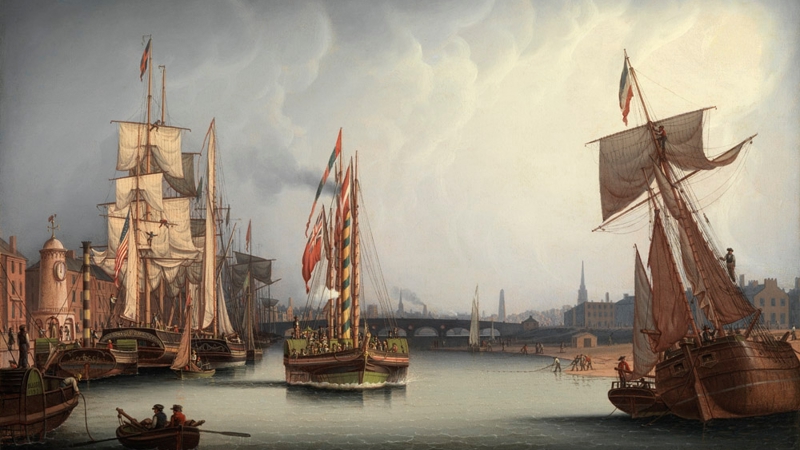Slave Cotton in Glasgow

Glasgow Excursion Steamers and American Ship on the Clyde by Robert Salmon
3715
Images © CSG CIC Glasgow Museums Collection
14th August 2018
When Glasgow Museums first acquired Robert Salmon’s painting of Glasgow Harbour in 1832 it was for the extraordinary representation of steamships. However research into the other ships has thrown up additional information that helps us to understand what is going on in the painting.
The American ship on the left-hand side of the painting was originally thought to have been there simply to appeal to Salmon’s American customers, as transatlantic cargo ships were traditionally thought to have docked at Greenock or Port Glasgow at this time. However, a notice in the Glasgow Herald from April 1826 indicates that the ship Lindsays, sailing from New Orleans, was due to berth at the Broomielaw.
This was the first transatlantic ship to sail directly into Glasgow. Further reports indicated that it was carrying a cargo of cotton for a number of Glasgow cotton merchants, including James Finlay & Co. When Kirkman Finlay took over his father’s firm in 1790 he rapidly expanded the business into cotton spinning and became the leading importer of raw cotton and exporter of cotton yarn. He then developed the business into India, becoming fantastically wealthy and one of the most influential merchants of the British Empire.
Although the painting is dated 1832, the artist left his home in Greenock in 1826 and after a brief stay in London was resident in Boston by 1828. The painting was therefore most likely painted from earlier notes and sketches, and it is entirely possible that the ship in the painting is the Lindsays. The ship on the right of the painting is German and could be on the Clyde to export cotton yarn to Finlay’s agents in Hamburg.
The painting was made shortly before the practice of slavery was outlawed in Britain and its colonies, but the cotton Finlay imported from New Orleans was very much the product of slave labour in the plantations of Southern America. His vast profits were therefore made directly from the products of slavery.
Finlay professed an ‘utter detestation of everything that savours of slavery’ but was an extremely reluctant abolitionist. He was one of the leading businessmen calling on the government to pay compensation for the loss of profit from the abolition of slavery, a man more concerned with money than morals.
Dr Martin Bellamy
Research & Curatorial Manager
